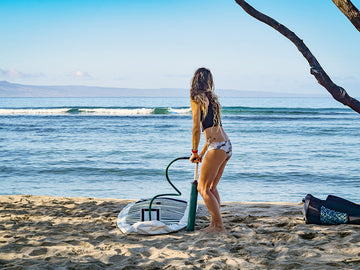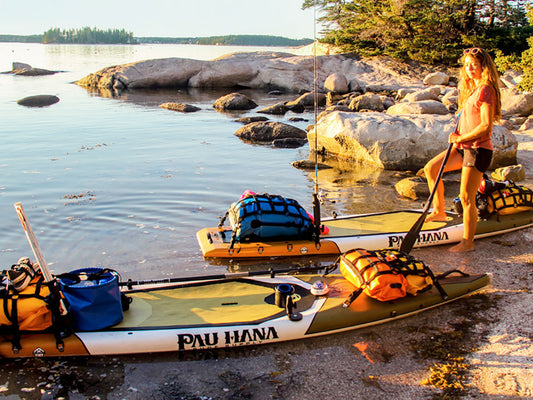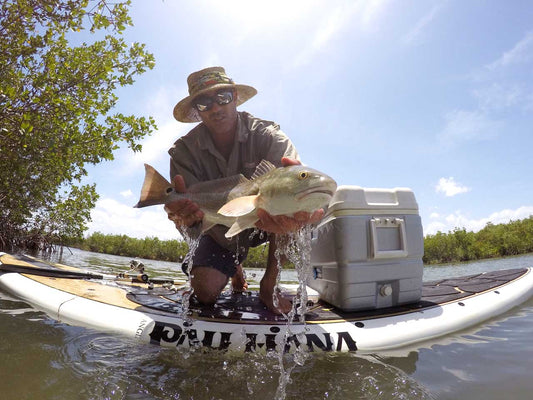How to Keep Your Inflatable SUP in Top Condition for Years of Adventures
Paddle boarding is an incredible way to explore Aotearoa's stunning beaches, lakes, and rivers while getting a workout. If you’re an inflatable SUP owner, taking good care of your board is essential to ensure it stays in top-notch condition for many seasons of adventure. Inflatable paddle boards (iSUPs) are built tough, but with the right care, they’ll last even longer, saving you the cost of repairs or replacement. Here’s a guide focused on inflatable SUP care, with a few tips for hard board owners too.
1. Regular Cleaning: Keep It Sweet
After each session, especially in saltwater, rinse your inflatable board with fresh water. Salt, sand, and debris can wear down your board’s surface over time. A periodic wash with mild, eco-friendly soap like Simple Green will help keep your board clean and smelling fresh (no one wants a board smelling like old jandals!).
In Aotearoa, cleaning isn’t just about maintenance—it's also about protecting our waterways. If you’re paddling in freshwater, be sure to follow the “Check, Clean, Dry” guidelines to prevent the spread of invasive species like didymo. Before moving your board between waterways, check it for algae or plant material, make sure you clean it with fresh water or a disinfectant, and ensure it's completely dry. This step is crucial to protect our environment and avoid fines.
2. Inflation and Pressure Management: Know the Sweet Spot
Inflatable boards require careful inflation. Follow the manufacturer's recommended PSI (typically between 12-15 PSI). Too little air makes your board floppy and hard to paddle, while over-inflation can strain the seams. Always inflate your board on a flat surface away from sharp objects. And if you’re storing it inflated for a long time, release some air to relieve internal pressure, this is especially important if it’s in a hot environment. Additionally store away from any heat sources or areas that are likely to have big temperature changes.
3. Sun Protection: Slip, Slop, Slap (Your iSUP)
New Zealand’s harsh UV rays can break down the material of inflatable boards over time. To prevent this, store your board out of direct sunlight when not in use. A storage bag with UV protection is an excellent investment, or, at the very least, find a shady spot. Prolonged exposure can cause fading, deamination and weaken the PVC fabric.
4. Storage: Deflate and Tuck It Away Right
One of the benefits of owning an inflatable board is how easy it is to store. After each session, deflate your board if you’re not using it for a while. Make sure it's completely dry before rolling it up and storing it in a cool, dry place. Avoid areas with extreme temperatures, like next to a heater in winter, as this can warp or weaken the materials. A storage bag helps keep your board protected from dust and any potential punctures during the off-season.
5. Transporting Your Inflatable SUP: Safe and Easy
Inflatable boards are super easy to transport. You can roll them up and toss them in the boot of your car or even check them in as luggage on a plane if you’re flying. If you choose to transport it on your car while inflated, make sure it’s securely strapped down with wide straps, but don’t over tighten as this can damage the rails of the board. Always place the board fin-side up to reduce wind resistance and damage to the car while driving.
6. Checking for Leaks and Punctures: Be Prepared
Inflatables are generally rugged and highly durable, but accidents happen. If you notice your board losing air or feel a “squishy” spot, check for leaks. Most inflatable SUPs come with a repair kit. To locate small leaks, spray soapy water on the board and watch for bubbles. Minor punctures can easily be patched, but for bigger damage that a repair kit won’t handle, head to a SUP repair specialist or contact the manufacturer.
7. Environmental Awareness: Handle with Care
New Zealand’s varied paddling environments, from rocky shores to forest-lined lakes, require you to be mindful of where you place your board. Avoid dragging your paddle board across sharp rocks, barnacles, or rough surfaces as not only can this damage your board but it can also put strain on delicate ecosystems. Taking extra care while launching or docking prevents unnecessary wear. And remember—if kids are playing on the board, keep an eye on them to avoid fin or seam damage and their safety!
8. Leash Up: Protect Your Board (And Yourself)
A SUP leash is an essential safety feature, as it helps you stay attached and prevents your board from drifting away from you or into trouble. Rocks and debris can cause scratches, dings, or punctures if your board gets away from you. A coiled SUP leash will keep your board close without dragging in the water.
9. Avoid Over-Inflating or Under-Inflating: The Goldilocks Zone
To get the best performance from your iSUP, you’ll want to maintain the correct pressure, for most paddle boards this is somewhere between 12-15psi. Inflating the board too much can put unnecessary stress on the seams, especially in hot weather when air expands. On the flip side, paddling with too little air makes your board less stable and harder to control. Consult the instruction manual or valve ring to find the ideal pressure for your board.
10. Proper Fin Care: Small But Mighty
Fins are key to stability and performance, so keep an eye on them. If your inflatable has removable fins, store them separately when rolling up the board to prevent bending or damage to the fin or board. Always inspect the fin box for debris or damage and make sure it’s properly attached before paddling out.
11. Lubrication and Rust Prevention: Don’t Forget the Small Stuff
Your inflatable paddle board probably doesn’t have as many metal parts as a hard board, but components like D-rings, leash plugs, and the inflation valve still need occasional care. Use a bit of silicone spray or household oil on these areas to prevent rust, especially if you’re paddling in salty waters.
12. Hard Boards: A Few Tips for the Solid SUPs
For those with hard boards, many of these tips still apply—especially cleaning, sun protection, and careful storage. Make sure you inspect for dings after each use and fix any minor damage with epoxy to avoid water intrusion. For larger damage you’ll need to seek the help of a qualified board repair service or reach out to the manufacturer. Be sure to transport your board with care, using proper straps and padding to prevent cracks.
Extra Tips for Paddlers
- Deep Inspections: Occasionally, give your inflatable a thorough check, especially the seams and valve. Small issues that are caught early are a lot easier to fix.
- Paddle Care: Your paddle is just as important as your board. make sure you check it for cracks or wear periodically and adjust it to the right height for the best paddling experience.
- Professional Check-Ups: Even if you’re diligent with your maintenance, it doesn’t hurt to get a professional to check your board every once in a while.
By following these simple steps, your inflatable SUP will stay in prime condition, ready for many more adventures on New Zealand’s beautiful waters. Take care of your board, and it’ll take care of you!





